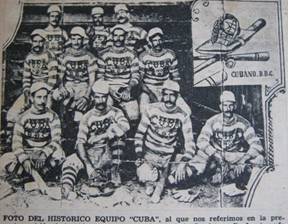
Baseball, also called “Pelota” (ball), for dozens of years has been the most popular sport in Cuba, as it attracts the large number of aficionados. The first news about it was in the year 1866, when they started to play it in our country, brought from the United States, where it was invented.
More detailed references to it are from the year 1878, when the Havana club was founded. The Almendares club was created later. The Havana club took up residence in El Vedado and Almendares in El Cerro, after moving in front of the Quinta de los Molinos. From here began the rivalry between the reds and the blues, which characterized both clubs during their entire existence.
In 1899 in Key West (U.S.) the Cuba club created, and it copied the red-blue rivalry, organizing a Havana club and Almendares club, like those on the island, plus a club called Key West Browns, on the base of the Fe club, which adopted the color brown.
The first Cuban baseball team that traveled to the United States was the All Cubans, debuting near New York. Later they were renamed the Cuban Stars. Most Cubans who went to the Major Leagues, had played on this team, including Adolfo Luque and Miguel Angel Gonzalez.

In the early twentieth century the clubs Havana, Almendares, Fe and Matanzas were enrolled in the National Championship. Then came some disappeared and others arose, among them the Marianao and Cienfuegos clubs which, along with Habana and Almendares, were the main four clubs of Cuban professional baseball.
In 1946 a Cuban team (Havana Cubans) joined the now defunct International League of Florida, and the same franchise was exalted after the International League Triple-A rating, a prelude to the big leagues, with the Cuban Sugar Kings.
All this professional baseball fed amateur baseball, which began operations in 1914 as the National League, with four teams competing: Vedado Tennis, Marianao Instituto and Club Atlético de Cuba. Later Progreso, Universidad de La Habana, Lawton, Bellamar, Cienfuegos, Ferroviarios, and Medina were added, and others.
Some remained for a long time and others disappeared over the years, still remembered by the fans of the Cubanaleco, Fortuna, Teléfonos, Artesanos, Ferroviarios clubs and others. The memory of those Caribbean and World Series, where the countries of America participated, is unforgettable.

Now, forgetting all that came before, it is said that the development of baseball in Cuba is due to the Revolution, for where once there were only four teams (there were six provinces, but they did not all have a team but were integrated with all the best players, plus some of other nationalities), there are currently seventeen (one per province).
Size has never been synonymous with quality. It is true that there is so many teams (all under the umbrella of professional amateurs), but none reaches the quality of any of the four professional baseball teams there were before (the majority of their members played in the Triple A and the Major Leagues).

Perhaps, if conducted two championships: a lower one, involving all the provincial teams, keeping them stable each year, no change of names, drawing on new players from the municipalities; and an higher one, with only four or six teams, also stable, comprising the best players, from the provincial teams, it would raise the tone would be more attractive and competitive, attract a larger attendance and baseball would win.
It is also important to free the players, and they could play on the team and place they wanted, both inside and outside the country, without being saddled, in the latter case, with the ridiculous label of traitors.
It seems that here, too, a thorough update is needed. Pretending to delete, from political paranoia, one hundred forty-five years of baseball in Cuba, and replace it with that played in the last fifty years, in addition to being an attack on national identity, shows a lack of respect for citizens.
Both in the amateur baseball in the colonial era, as in the professional and amateur of the republican era, the professional disguised as amateur in recent times, and it really is amateur, is Cuban baseball. It has been and is only one thing, from the beginning until today.
January 21 2012
